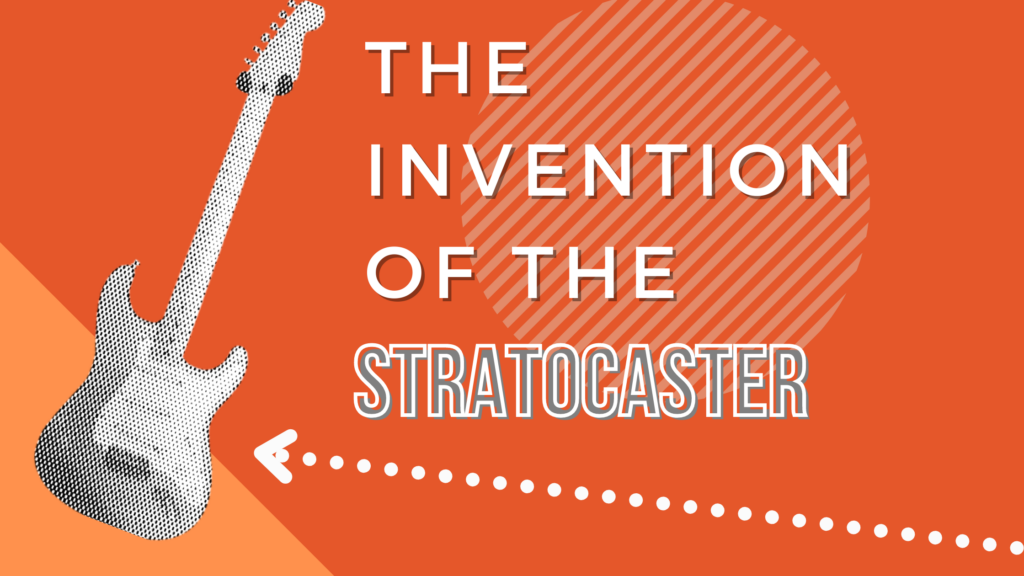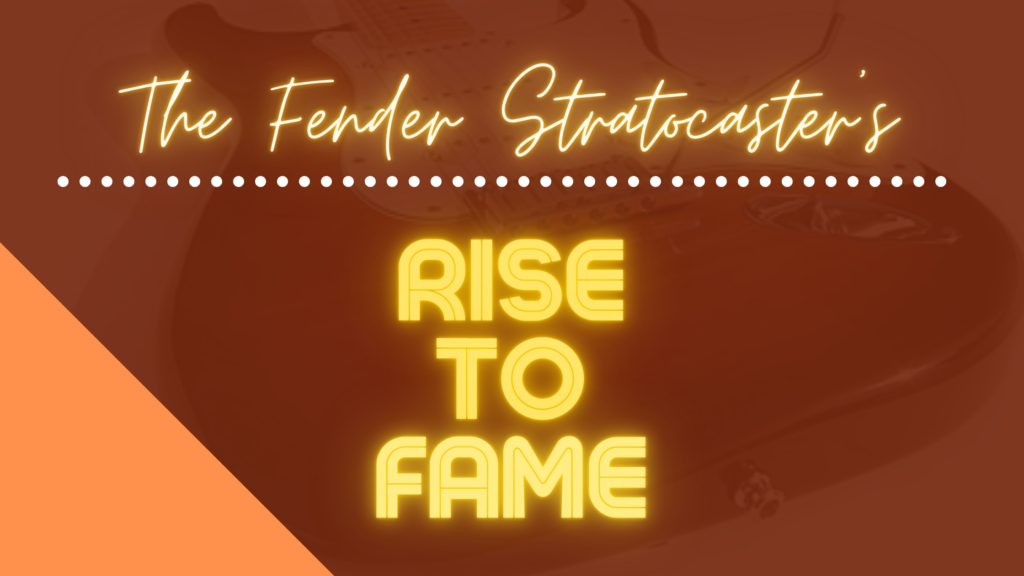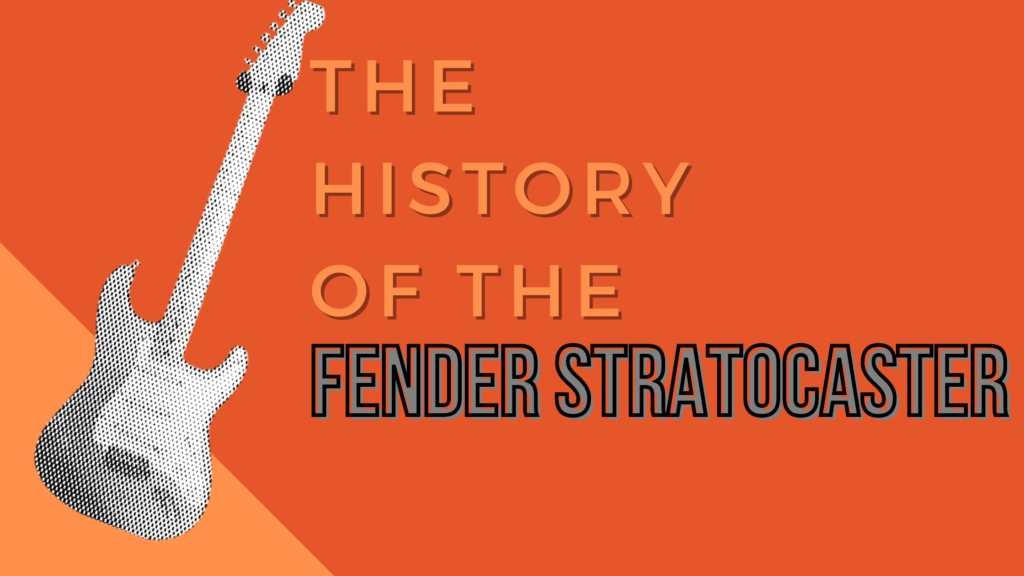The Fender Stratocaster is the archetype of the electric guitar, recognized globally by its innovative deep contours and unique double-horned body style. An icon of the music industry, the Stratocaster has been used by rock n’ roll Hall of Famers, electric blues guitarists, modern country artists and other musicians around the world.The Stratocaster has become more than just an instrument and represents individuality, creativity, and artistry. Since its invention in 1954, the Stratocaster has remained true to its identity as an innovative, practical guitar with a beautiful tone and high-quality design. Though there have been a few bumps along the way, the Fender Stratocaster has undoubtedly earned its place in music history as one of the most popular electric guitars ever created.
The Invention of the Stratocaster

The story of the Fender Stratocaster begins in the late 1930s, when Clarence Leonidas “Leo” Fender opened Fender Radio Service in Fullerton, California. Fender sold sheet music, phonograph records and home public address systems, in addition to building custom amplifiers and guitars for local musicians.During this period, jazz guitarists were searching for a solution for their instruments to be heard better over the powerful brass instruments in their ensembles. Some jazz musicians attempted to amplify their acoustic guitars, but this created unappealing feedback. There were some electric guitars on the market at this time, but these were primarily lap steel guitars, not standard Spanish-style guitars. As his success building guitars and amps continued to grow, Leo Fender set out to create a better electric guitar — one that resembled a Spanish-style guitar and produced a high-quality sound when amplified.In 1946, Fender renamed his shop the Fender Electric Instruments Company and focused on developing electric guitars and basses. Fender’s revolutionary idea was to create solid body instruments instead of adapting hollow-bodied acoustic instruments for amplification. In 1951, this innovation resulted in the first solid body electric guitar ever commercially produced — the Fender Telecaster. Soon after, Fender released the revolutionary solid body Precision Bass guitar.Luckily, Fender did not stop there. Alongside Freddy Tavares and George Fullerton, Fender continued to work on a model that would improve upon and succeed the Telecaster, which involved developing new pickups and a new bridge. Initially, the prototype of the Fender Stratocaster closely resembled the Telecaster before it, but just before its release, Tavares sketched a new design for the Stratocaster that featured the double-horned shape of the Precision Bass. This sleek and unique body style would come to be a defining feature of the Stratocaster that made it not just a succession of the Telecaster, but an instrument all its own.
1954: The First Fender Stratocaster
After years of development, the first Fender Stratocaster was introduced in 1954. The Stratocaster had three newly designed pickups that offered controls for greater tonal versatility, as well as the ability to accommodate heavy string gauges. The Stratocaster’s innovative body shape featured curved edges and double cutaways, making it extremely comfortable to play. The headstock was also uniquely curved with all the tuners easily within reach on the same side. The first Stratocaster was built with solid ash tonewood and had a two-colored sunburst finish of brownish-black fading to canary yellow.However, arguably the most significant advancement of the Fender Stratocaster was its synchronized vibrato system that offered stable tuning, exceptional tone, great sustain and ease of use. The Stratocaster’s unique bridge hovered above the neck and moved with the guitar strings. Doubling the Telecasters three bridge saddles, the Strat boasted six bridge saddles that allowed the height and length of each string to be adjusted individually. Pitch could be raised and lowered easily with a detachable tremolo arm. This design was so effective that it was capable of much larger pitch spans than Fender himself even imagined.The 1954 Stratocaster was designed to compete with other high-end models of its time, including Gibson’s Les Paul. While it would take over a decade for the Stratocaster to gain widespread popularity, it eventually became one of the most popular guitars ever produced.
The Fender Stratocaster’s Rise To Fame

After its 1954 release, the Fender Stratocaster was not an instant success. On the contrary, many professional musicians did not view it as a serious instrument, and some even saw it as a joke.Coming from a small regional company whose founder did not even play guitar, Leo Fender’s new Stratocaster was understandably met with skepticism. The Strat would eventually become an iconic part of the rock n’ roll music that was just beginning to gain steam, but it was not originally intended for rock n’ roll. Instead, western swing and pop musicians such as Buddy Merrill, Eddie Cletro and Alvino Rey picked up the Fender Strat.Over the next three years, Fender continued to revise the Stratocaster, until he achieved the classic 1957 model that would remain largely the same ever since. The same year, the Stratocaster earned public spotlight when the young Buddy Holly appeared on The Ed Sullivan show with a Strat in hand and strummed “That’ll Be the Day” and “Peggy Sue.” The Stratocaster slowly but surely gained momentum, becoming popular among blues guitarists like Ike Turner, Buddy Guy, Pee Wee Crayton, Eldon Shamblin, Bill Carson and Otis Rush. In 1957, the Fender company began offering custom colored Stratocasters in addition to the traditional sunburst finish.With the rise of surf rock in the early 1960s, the Strat began to find a home among rock n’ roll artists. Early surf music pushed electric guitar to center stage, and the youthful California music paired well with the California-born Strat. In the hands of The Beach Boys’ guitarist Al Jardine, the Stratocaster became a nationally recognized instrument.However, the artist that truly secured the Stratocaster’s place in music history was undoubtedly Jimi Hendrix. Appearing seemingly out of nowhere in the mid-1960s, Hendrix took the music world by storm. Hendrix almost exclusively played a Stratocaster, sometimes smashing and burning them onstage during his mesmerizing concerts. After Hendrix, other rock artists picked up the Strat, including Eric Clapton, The Who’s Pete Townshend and The Beatles’ guitarists John Lennon and George Harrison on Help!, Rubber Soul and Revolver.
The CBS Corporation Takeover
In the background of Fender’s rise to fame, the company was experiencing some significant changes. In 1965, Leo Fender, who was suffering from health problems, sold the company to Columbia Broadcasting System Corporation (CBS). The corporate takeover coupled with the popularity of Fender Stratocasters in the late 1960s led to a decline in the instrument’s quality as CBS struggled to keep up with high consumer demands.By the mid-1970s the Stratocaster was more popular than it had ever been, but the instruments being produced were much lower quality than earlier models. As guitarists began to recognize these cut corners, Fender’s reputation and popularity declined. Desperate to turn the company around, CBS recruited three top executives from Yamaha Musical Instruments: William Schultz, John McLaren and Dan Smith.
Rebuilding the Fender Brand
A few years after becoming the president of Fender under CBS, William Schultz bought out the company in 1985. The sale included only a few patents and the Fender name, but no machinery or facilities. Schultz renamed the company Fender Musical Instruments Corporation and began rebuilding the Fender brand from the ground up. In the 1985 catalog, only Japanese models of Fenders were sold, as no production was occurring in the U.S.Two years later, U.S. production began again when Fender opened a custom shop in Corona, California. The American Standard Strat was released, and the Fender Custom Shop quickly became popular for releasing limited-run guitars and custom hand-built guitars. The new company also capitalized on their return to the Fender roots by offering reissues of popular vintage models. From the start of the Fender company, they were known for customizing guitars for individual artists, and today, some of the world’s best guitarists still work with the Fender Custom Shop in Corona.In 1991, Fender moved their headquarters from California to Scottsdale, Arizona, to manage their now global company. In 1998, they built a new 176,000 square-foot facility in Corona that continues to produce some of Fender’s top guitar models today. Over the decades, Fender has offered artist series Stratocasters for famous Strat players like Eric Clapton, Kurt Cobain, Stevie Ray Vaughn, Yngwie Malmsteen, Buddy Guy and Jimi Hendrix. In 2004, Fender celebrated the 50th anniversary of the Stratocaster by releasing a replica of the 1954 original.
Fender Stratocaster Changes by Year

Throughout its history, the Fender Stratocaster has gone through a few ups and downs, but its design has not changed much since the classic 1957 model. The company has made several small advancements to improve its sound quality and ease of use, including some distinctive changes during the CBS period.Here are a few significant milestones in the timeline of Fender Stratocaster history:
- 1955: This second model of the Stratocaster looked much like the first, but with an improved build quality and a lighter design, making it easier to play than the heavier 1954 model.
- 1956: Fender changed the body tonewood for the Stratocaster from ash to the more workable and affordable alder. The neck of the 1956 model evolved from the original U-shaped neck to a sharper V-shaped neck.
- 1957: Recognized as a classic model, the 1957 Strat featured ABS plastic instead of polystyrene on the pickguards, control knobs and pickup covers, and more user-friendly butterfly string trees instead of the original circular string tree. The model retained the V-shaped neck and iconic yellow and black sunburst finish.
- 1958: Fender returned to a thin U-shaped neck in this model and added a red transition hue to the sunburst finish.
- 1959: The 1959 model brought several changes in the Stratocaster’s design and quality, including a thinner neck and new multi-layer celluloid pickguard with a greenish tint. Fender started using Brazilian rosewood fretboards instead of the original one-piece maple neck and fingerboard. This new “slab” style fingerboard was glued on top of the maple neck. The fingerboard dots changed from original black dots to white clay dots.
- 1961: To make the fretboard more comfortable, they made it rounder and thinner. This C-shaped neck produced a thinner sound and is still a standard Stratocaster neck shape today. The 1961 Fender Stratocaster also featured an improved three-color sunburst finish that would not fade when exposed to UV light. They also added patent numbers to the headstock logo decal.
- 1963: The 1963 Fender Stratocaster featured a less curvaceous body than previous models and removed the body dates.
- 1964: Ten years after the original model was released, the headstock logo was redesigned with a thicker script. This logo, which would be removed a few years later under CBS’s management, is often referred to as the “transition” logo.
- 1965: At the start of the CBS era, the Stratocaster’s finishing process changed to produce a bolder yellow and to allow less expensive body tonewood to be used. The fingerboard dots were replaced with cheaper Pearloid fingerboard dots, and the body contours became even less dramatic. The minty green celluloid pickguards were replaced with three-layer white plastic pickguards that were more brittle and prone to breaking.
- 1966: In 1966, the most visible CBS alternation to the Stratocaster — a larger and slightly reshaped headstock — was introduced. The enlarged headstock allowed for a larger logo decal and became a defining characteristic of CBS-era Stratocasters. Many Fender fans disliked the oversized headstock, but others continue to prefer this style today. The CBS Corporation also produced Strats with three bolts on the neck joint instead of four.
- 1968: The logo released in 1964 changed again in mid-1968, when the moved it to be under, instead of over, the finish. They used thicker finish undercoats, and F-style tuners replaced the original Kluson-Deluxe tuners. The 1968 Stratocaster also saw the return of the single-piece maple neck and fingerboard.
- 1980: At the end of the CBS era, the headstock returned to the original smaller design and used four bolts for the neck joint. The Fender company began producing electric guitars of the same quality as their vintage models from the 50s and early 60s.
The Fender Stratocaster Today
Fender guitars are now made in the company’s U.S. factories, as well as facilities in Japan and Mexico. Fender’s lineup still includes the iconic Telecaster, Precision Bass and Stratocaster that once formed the foundation of the brand. Modern Fender Stratocasters offer improved tuners and a comfortable C-shaped neck, as well as a lightweight design.Strats are available in a variety of models with nearly endless customization options, including the fretboard material, neck shape and finish color. Artist Series Stratocasters and reissued replicas of classic Fender Strats remain popular among guitarists and fans. Musicians of any genre can create a customized Stratocaster through the Custom Shop or find a beautiful vintage model reminiscent of the iconic guitar’s roots.
